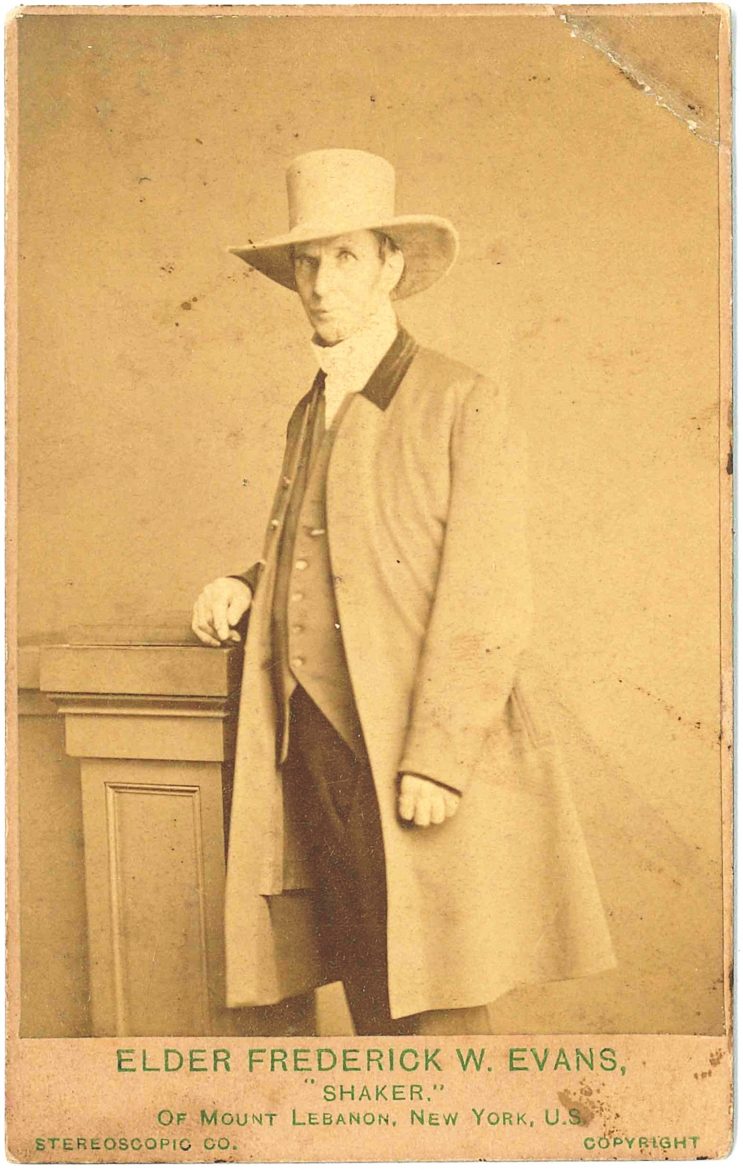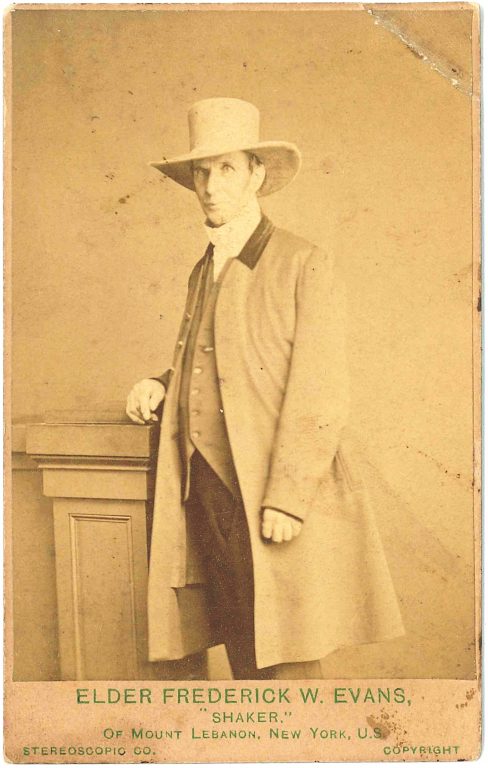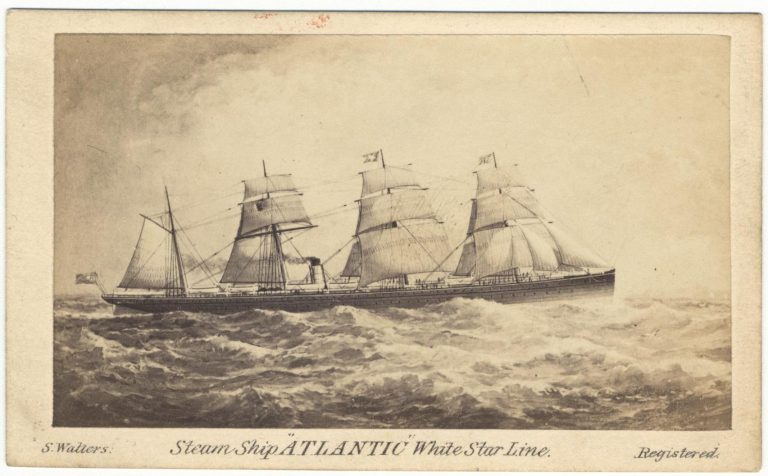
Carte-de Visite, Elder Frederick W. Evans “Shaker,” 1871, The London Stereoscopic & Photographic Company, London. Shaker Museum | Mount Lebanon: 2020.3.1.
The Shaker Museum recently acquired a carte-de-visite of Elder Frederick Evans. Taken in London, it may well be the only 19th century photograph of a Shaker outside the United States. This is the story of how he ended up there. Spiritualism emerged as a religious movement in America in 1848 when Kate and Maggie Fox convinced some of their […]
The Shaker Museum recently acquired a carte-de-visite of Elder Frederick Evans. Taken in London, it may well be the only 19th century photograph of a Shaker outside the United States. This is the story of how he ended up there.

Carte-de Visite, Elder Frederick W. Evans “Shaker,” 1871, The London Stereoscopic & Photographic Company, London. Shaker Museum | Mount Lebanon: 2020.3.1.
Spiritualism emerged as a religious movement in America in 1848 when Kate and Maggie Fox convinced some of their Hydesville, NY neighbors they were in communication with otherworldly spirits who answered the sisters’ questions with intelligible knocking sounds. The Shakers, since their inception, received spiritual communications and during the previous decade experienced a particularly intense time of visitations from the spirits of departed Shakers and others, and so took an almost immediate interest in the Fox phenomenon. The members of the North Family at Mount Lebanon in particular seemed to hold out some hope that Spiritualists were fertile ground for a harvest of new Shakers. Just after Christmas 1870, therefore, when the Spiritualist leader James Martin Peebles invited Elder Frederick Evans to attend a Spiritualist convention in Cleveland, Ohio, the Elder accepted. Elder Frederick, accompanied by Brother Albert Lomas from Watervliet, left home to attend the Fourth National Spiritualist Convention on January 4, 1871. His appearance at the convention cemented a firm relationship with Peebles – on February 8th a North Family journalist recorded that “J. M. Peebles the leading Spiritualist unites with believers & becomes associated with the Elders in joint conventions of Spiritualist and Shakers at Cleveland & Troy.”
Peebles did not fully “unite” with Believers but clearly was in frequent communications with Elder Frederick. He hatched a plan and on June 3rd the Mount Lebanon Ministry’s journal recorded that,” J.M. Peebles, on his knees, implores the brethren and Sisters to let Elder Frederick. W. Evans go to England with him on the first of July coming.” The Ministry consented.
On June 11th the Ministry attended Sunday’s public meeting and “opened the gift for Elder Frederick to go on a mission to England,” and on June 19th Elder Frederick traveled to New York City to purchase round-trip tickets for himself and Peebles on the White Star Line’s Screw Steamship Atlantic – Captain Digby Murray – for $292.56. Following a farewell meeting with the Canaan Shaker Families, Elder Frederick, accompanied by Brother Charles Greaves and Sisters Anna White and Hannah Wilson, left home for New York to board the ship to England.

Carte-de-Visite, S. S. Atlantic, ca. 1871. Retrieved from: https://en.wikipedia.org/wiki/White_Star_Line
SS Atlantic was a new ship, built for the White Star Line at the Harland & Wolff shipyard in Belfast, Ireland. Constructed of iron, it was 420 feet long with a 41 foot beam and a depth of 23 feet. It had one funnel and four masts rigged for sailing. Eleven boilers supplied a four-cylinder 600 horsepower engine powering a single screw could push the ship along at 14 knots. It accommodated 166 first-class passengers and 1,000 third-class passengers. Atlantic launched in Belfast on December 1, 1870 and made its home port in Liverpool. Her maiden voyage was on June 8, 1871, stopping at Queenstown (now Cobh), Ireland, to take on more passengers – and then on to New York. (Two years later, on its 19th voyage, SS Atlantic sank near Halifax, losing more than half of its 975 passengers. This was the worst loss of lives on a transatlantic voyage until Titanic was lost in 1912.)
“A certain magnificence marked the adornments and upholstery of the Atlantic. The saloon was 80 feet long, and extended entirely across for a width of 40 feet. The lounges and fixed seats were upholstered in crimson velvet. The panels of the saloon were damask, white, and pink; and the pilasters, brackets, and cornices were of teak nicked out with gold. The bed hangings of the staterooms and sleeping berths, which were large and commodious, were of green reps; and the appointments were in all respects elegant and complete.
–Loss of the Steam Ship “Atlantic,” published 1873 from Canadian Institute for Historical Micro reproductions (CIHM) #26654 Retrieved from: http://www.skiphowlett.net/Web_Page/Atlantic.htm
Elder Frederick and Peebles , who undoubtedly traveled as first-class passengers, boarded Atlantic on July 1, 1871 for the ship’s first return voyage to her home port at Liverpool. According to a North Family journal the trip took “8 days & 19 hours from land to land; 10 days from dock to dock.” While in transit Elder Frederick and Peebles had the opportunity to share interesting conversations with fellow passenger George Francis Train – best known for circumnavigating the globe and possibly being the model for Phineas Fogg in Jules Verne’s Around the World in Eighty Days. On July 12th the duo arrived in London. On July 23rd Elder Frederick lectured an audience primarily composed of English Spiritualists in Cleveland Hall. He recorded his experience in a letter to the editor of The Golden Age reprinted in the October issue of The Shaker:
The attendance was small, but increased with each succeeding call, until I decided to give all who wished to hear and see a Shaker, an opportunity to do so, by engaging St. George’s Hall and inviting Hepworth Dixon to occupy the chair. But I had sadly miscalculated the slow, unexcitable, and unfanatical English mind, as not more than a third of the people who came could get into the hall.”

St. George’s Hall, Langham Place, London, ca. 1867, from the Illustrated London News. Retrieved from: http://www.arthurlloyd.co.uk/StGeorgesHallLanghamPlaceLondon.htm
The St. George’s Hall lecture was held on August 6th – the 97th anniversary of the Mother Ann Lee and her followers landing in New York City – and Peebles provided an account of the lecture in a letter to The Shaker:
The large hall was densely packed before the hour for service. After the lecture commenced, a continual stream reached the outer door, and then left, unable to gain admission. There were present, members of Parliament, distinguished journalists, prominent Darwinians, clergymen, Spiritualist, Secularists, social reformers. The music was excellent. And never have we seen greater attention paid to a speaker than to Elder Evans upon this occasion. The ‘Spirit of the Lord was upon him.’ Occasionally there was a dissent; as, for instance, when he advised the English to dispense with the ‘bishops and noblemen constituting the ‘House of Lords,’ and put women in their places!
While in England, Elder Evans met with and lectured to the Co-operative Emigration Society, The Temperance League, and “the Woman Suffrage people.” He traveled to the Midlands and lectured to Spiritualists at an outdoor meeting at Bowling Hill near Bradford – just 40 kilometers northeast of Manchester, Ann Lee’s birthplace. The Elder returned on SS Atlantic under the command of Captain Hamilton Perry, arriving in New York harbor on September and disembarking the next day, at which time he was met by a party of Shakers including Eldress Antoinette Doolittle, Br. Albert Lomas, Sister Hannah Wilson, and Sister Harriet Bullard. Elder Frederick was accompanied on his return trip by Peebles, James Haase, Julia Wood, Edwin Clarke, and Annie Rosetta Stephens – the presumed “first fruits” of his English harvest. Of those who he brought with him, only Annie Rosetta Stephens remained a Shaker. Haase and Wood had been members of a group who were followers of Mary Ann Girling – better known as the New Forest Shakers in England – but that is a story for another post.